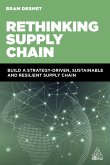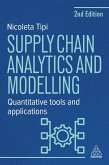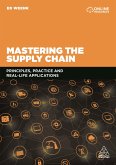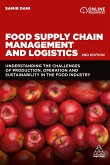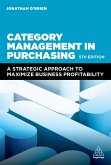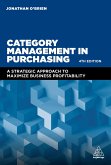- Broschiertes Buch
- Merkliste
- Auf die Merkliste
- Bewerten Bewerten
- Teilen
- Produkt teilen
- Produkterinnerung
- Produkterinnerung
Explore the future and application of circular operations so that you can build a roadmap towards a circular supply chain.
Andere Kunden interessierten sich auch für
![Rethinking Supply Chain Rethinking Supply Chain]() Dr BRAM DESMETRethinking Supply Chain41,99 €
Dr BRAM DESMETRethinking Supply Chain41,99 €![Supply Chain Analytics and Modelling Supply Chain Analytics and Modelling]() Dr Nicoleta TipiSupply Chain Analytics and Modelling46,99 €
Dr Nicoleta TipiSupply Chain Analytics and Modelling46,99 €![Mastering the Supply Chain Mastering the Supply Chain]() Ed WeenkMastering the Supply Chain36,99 €
Ed WeenkMastering the Supply Chain36,99 €![Food Supply Chain Management and Logistics Food Supply Chain Management and Logistics]() Samir DaniFood Supply Chain Management and Logistics81,99 €
Samir DaniFood Supply Chain Management and Logistics81,99 €![Food Supply Chain Management and Logistics Food Supply Chain Management and Logistics]() Samir DaniFood Supply Chain Management and Logistics70,99 €
Samir DaniFood Supply Chain Management and Logistics70,99 €![Category Management in Purchasing Category Management in Purchasing]() Jonathan O'BrienCategory Management in Purchasing42,99 €
Jonathan O'BrienCategory Management in Purchasing42,99 €![Category Management in Purchasing Category Management in Purchasing]() Jonathan O'BrienCategory Management in Purchasing73,99 €
Jonathan O'BrienCategory Management in Purchasing73,99 €-
-
-
Explore the future and application of circular operations so that you can build a roadmap towards a circular supply chain.
Produktdetails
- Produktdetails
- Verlag: Kogan Page Ltd
- Seitenzahl: 448
- Erscheinungstermin: 3. Juni 2025
- Englisch
- Abmessung: 155mm x 233mm x 26mm
- Gewicht: 658g
- ISBN-13: 9781398620674
- ISBN-10: 139862067X
- Artikelnr.: 71605747
- Herstellerkennzeichnung
- Libri GmbH
- Europaallee 1
- 36244 Bad Hersfeld
- gpsr@libri.de
- Verlag: Kogan Page Ltd
- Seitenzahl: 448
- Erscheinungstermin: 3. Juni 2025
- Englisch
- Abmessung: 155mm x 233mm x 26mm
- Gewicht: 658g
- ISBN-13: 9781398620674
- ISBN-10: 139862067X
- Artikelnr.: 71605747
- Herstellerkennzeichnung
- Libri GmbH
- Europaallee 1
- 36244 Bad Hersfeld
- gpsr@libri.de
Deborah Dull
Section
ONE: Forming circular supply chains from key concepts; Chapter
00: Introduction; Chapter
01: Events leading to today's economy; Chapter
02: The pioneers of circular thinking; Chapter
03: Where circular economy meets supply chain; Chapter
04: Building tomorrow's circular supply chain; Section
TWO: The capability to repair at scale; Chapter
05: People and culture capabilities
repairing at scale; Chapter
06: Process capabilities
orchestrating circular flows to repair at scale; Chapter
07: Technology capabilities
digital enablement to repair at scale; Chapter
08: Industry standards capabilities
common language for circularity to repair at scale; Chapter
09: Governance capabilities
ensuring circular success to repair at scale; Section
THREE: The capability to manufacture in
market; Chapter
10: People and culture capabilities
manufacturing in
market; Chapter
11: Process capabilities
orchestrating circular flows to manufacture in
market; Chapter
12: Technology capabilities
digital enablement to manufacture in
market; Chapter
13: Standards capabilities
common language for circularity to manufacture in
market; Chapter
14: Governance capabilities
ensuring circular success to manufacture in
market; Section
FOUR: The capability to circulate locally; Chapter
15: People and culture capabilities
circulating locally; Chapter
16: Process capabilities
orchestrating circular flows to circulate locally; Chapter
17: Technology capabilities
digital enablement to circulate locally; Chapter
18: Standards capabilities
common language for circularity to circulate locally; Chapter
19: Governance capabilities
ensuring circular success to circulate locally; Section
FIVE: The capability to collaborate transparently; Chapter
20: People and culture capabilities
collaborating transparently; Chapter
21: Process capabilities
orchestrating circular flows to collaborate transparently; Chapter
22: Technology capabilities
digital enablement to collaborate transparently; Chapter
23: Standards capabilities
common language for circularity to collaborate transparently; Chapter
24: Governance capabilities
ensuring circular success to collaborate transparently; Section
SIX: Conclusion; Chapter
25: Next steps;
ONE: Forming circular supply chains from key concepts; Chapter
00: Introduction; Chapter
01: Events leading to today's economy; Chapter
02: The pioneers of circular thinking; Chapter
03: Where circular economy meets supply chain; Chapter
04: Building tomorrow's circular supply chain; Section
TWO: The capability to repair at scale; Chapter
05: People and culture capabilities
repairing at scale; Chapter
06: Process capabilities
orchestrating circular flows to repair at scale; Chapter
07: Technology capabilities
digital enablement to repair at scale; Chapter
08: Industry standards capabilities
common language for circularity to repair at scale; Chapter
09: Governance capabilities
ensuring circular success to repair at scale; Section
THREE: The capability to manufacture in
market; Chapter
10: People and culture capabilities
manufacturing in
market; Chapter
11: Process capabilities
orchestrating circular flows to manufacture in
market; Chapter
12: Technology capabilities
digital enablement to manufacture in
market; Chapter
13: Standards capabilities
common language for circularity to manufacture in
market; Chapter
14: Governance capabilities
ensuring circular success to manufacture in
market; Section
FOUR: The capability to circulate locally; Chapter
15: People and culture capabilities
circulating locally; Chapter
16: Process capabilities
orchestrating circular flows to circulate locally; Chapter
17: Technology capabilities
digital enablement to circulate locally; Chapter
18: Standards capabilities
common language for circularity to circulate locally; Chapter
19: Governance capabilities
ensuring circular success to circulate locally; Section
FIVE: The capability to collaborate transparently; Chapter
20: People and culture capabilities
collaborating transparently; Chapter
21: Process capabilities
orchestrating circular flows to collaborate transparently; Chapter
22: Technology capabilities
digital enablement to collaborate transparently; Chapter
23: Standards capabilities
common language for circularity to collaborate transparently; Chapter
24: Governance capabilities
ensuring circular success to collaborate transparently; Section
SIX: Conclusion; Chapter
25: Next steps;
Section
ONE: Forming circular supply chains from key concepts; Chapter
00: Introduction; Chapter
01: Events leading to today's economy; Chapter
02: The pioneers of circular thinking; Chapter
03: Where circular economy meets supply chain; Chapter
04: Building tomorrow's circular supply chain; Section
TWO: The capability to repair at scale; Chapter
05: People and culture capabilities
repairing at scale; Chapter
06: Process capabilities
orchestrating circular flows to repair at scale; Chapter
07: Technology capabilities
digital enablement to repair at scale; Chapter
08: Industry standards capabilities
common language for circularity to repair at scale; Chapter
09: Governance capabilities
ensuring circular success to repair at scale; Section
THREE: The capability to manufacture in
market; Chapter
10: People and culture capabilities
manufacturing in
market; Chapter
11: Process capabilities
orchestrating circular flows to manufacture in
market; Chapter
12: Technology capabilities
digital enablement to manufacture in
market; Chapter
13: Standards capabilities
common language for circularity to manufacture in
market; Chapter
14: Governance capabilities
ensuring circular success to manufacture in
market; Section
FOUR: The capability to circulate locally; Chapter
15: People and culture capabilities
circulating locally; Chapter
16: Process capabilities
orchestrating circular flows to circulate locally; Chapter
17: Technology capabilities
digital enablement to circulate locally; Chapter
18: Standards capabilities
common language for circularity to circulate locally; Chapter
19: Governance capabilities
ensuring circular success to circulate locally; Section
FIVE: The capability to collaborate transparently; Chapter
20: People and culture capabilities
collaborating transparently; Chapter
21: Process capabilities
orchestrating circular flows to collaborate transparently; Chapter
22: Technology capabilities
digital enablement to collaborate transparently; Chapter
23: Standards capabilities
common language for circularity to collaborate transparently; Chapter
24: Governance capabilities
ensuring circular success to collaborate transparently; Section
SIX: Conclusion; Chapter
25: Next steps;
ONE: Forming circular supply chains from key concepts; Chapter
00: Introduction; Chapter
01: Events leading to today's economy; Chapter
02: The pioneers of circular thinking; Chapter
03: Where circular economy meets supply chain; Chapter
04: Building tomorrow's circular supply chain; Section
TWO: The capability to repair at scale; Chapter
05: People and culture capabilities
repairing at scale; Chapter
06: Process capabilities
orchestrating circular flows to repair at scale; Chapter
07: Technology capabilities
digital enablement to repair at scale; Chapter
08: Industry standards capabilities
common language for circularity to repair at scale; Chapter
09: Governance capabilities
ensuring circular success to repair at scale; Section
THREE: The capability to manufacture in
market; Chapter
10: People and culture capabilities
manufacturing in
market; Chapter
11: Process capabilities
orchestrating circular flows to manufacture in
market; Chapter
12: Technology capabilities
digital enablement to manufacture in
market; Chapter
13: Standards capabilities
common language for circularity to manufacture in
market; Chapter
14: Governance capabilities
ensuring circular success to manufacture in
market; Section
FOUR: The capability to circulate locally; Chapter
15: People and culture capabilities
circulating locally; Chapter
16: Process capabilities
orchestrating circular flows to circulate locally; Chapter
17: Technology capabilities
digital enablement to circulate locally; Chapter
18: Standards capabilities
common language for circularity to circulate locally; Chapter
19: Governance capabilities
ensuring circular success to circulate locally; Section
FIVE: The capability to collaborate transparently; Chapter
20: People and culture capabilities
collaborating transparently; Chapter
21: Process capabilities
orchestrating circular flows to collaborate transparently; Chapter
22: Technology capabilities
digital enablement to collaborate transparently; Chapter
23: Standards capabilities
common language for circularity to collaborate transparently; Chapter
24: Governance capabilities
ensuring circular success to collaborate transparently; Section
SIX: Conclusion; Chapter
25: Next steps;


